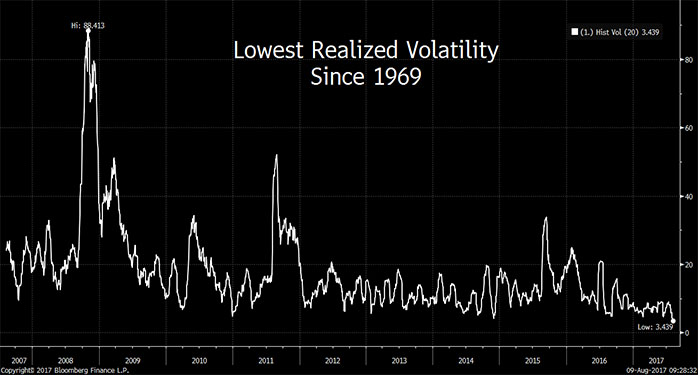Low volatility has been the hallmark for this year’s market. We have seen the lowest level on record for the volatility index (VIX) and the lowest realized volatility in the S&P 500 Index. The reason we have such low volatility in the market is clear: The macro environment is very benign and investors know it.
Looking at the market now, here is where we stand:
- Economic growth is decent, but not spectacular, and we are seeing synchronized growth globally for the first time since 2008.
- Inflation is low but there is no risk of deflation. Low inflation means the Federal Reserve (Fed) is in no rush to tighten monetary policy, another positive for risk assets.
- The job market is robust with limited wage pressure. Consumers’ balance sheets are fairly healthy and they are spending.
- Corporate earnings went down in 2015 and 2016, but they are rebounding strongly this year. In the first quarter of this year, S&P 500 Index earnings were up 13% year-over-year. In the second quarter, earnings were up 10%.
This benign environment provides the fundamental support for such low volatility this year. Most investors recognize this, and they are not looking at every data point for confirmation, therefore reducing the impact of major economic data releases on the markets. For example, the options market usually prices in a 6 to 7 basis points (bps) move for the 10-year Treasury rate when the jobs report is released. However, in the last three months, the options market only priced in 3 to 4 bps moves because investors know the job market is robust and they are not changing their view or positioning based on one data point.
Technically, we have $158 billion flowing into equities year to date, which is the second highest equity inflow since 2008 (the largest inflow happened in 2013). Strong equity inflows support the equity markets. On TD Ameritrade and Charles Schwab’s earning calls, both mentioned near record new account openings. This might be because of the recent cut in trade commissions, but also a reflection of the high participation of retail investors in the stock market this year.
This extremely quiet market makes a lot of investors uneasy. However, as I have shared in the past, even though asset valuation is rich and I see many possible reversals that make me uneasy, there is no widespread excess in the economy. This makes the current market very different.
In past cycles, when a recession starts, the Fed eases and asset prices start to recover, prompting an economic recovery soon after. This time, the economic recovery after the 2009 asset bottom was very feeble, and we were experiencing the Euro crisis and commodity bust. These factors forced the Fed to ease aggressively and persistently. After eight years of monetary stimulus and the second longest bull market in history, we are finally starting to see the return of the “animal spirit.” In short, the financial asset valuation recovery has been running ahead of the economic recovery this time, because the asset market has been used to stimulate the economy via the wealth effect. This is also how we get to today’s environment of decent economic growth, very low volatility and rich asset valuation.
Key TakeawaysVolatility tends to revert to the mean. Currently, market volatility is very low because of a decent economy, strong corporate earnings and the return of the retail investors. Looking forward, I will watch inflation data and bond yields. Higher inflation or bond yields will be a signal for higher market volatilities.
The material provided here is for informational use only. The views expressed are those of the author, and do not necessarily reflect the views of Penn Mutual Asset Management.
This material is for informational use only. The views expressed are those of the author, and do not necessarily reflect the views of Penn Mutual Asset Management. This material is not intended to be relied upon as a forecast, research or investment advice, and it is not a recommendation, offer or solicitation to buy or sell any securities or to adopt any investment strategy.
Opinions and statements of financial market trends that are based on current market conditions constitute judgment of the author and are subject to change without notice. The information and opinions contained in this material are derived from sources deemed to be reliable but should not be assumed to be accurate or complete. Statements that reflect projections or expectations of future financial or economic performance of the markets may be considered forward-looking statements. Actual results may differ significantly. Any forecasts contained in this material are based on various estimates and assumptions, and there can be no assurance that such estimates or assumptions will prove accurate.
Investing involves risk, including possible loss of principal. Past performance is no guarantee of future results. All information referenced in preparation of this material has been obtained from sources believed to be reliable, but accuracy and completeness are not guaranteed. There is no representation or warranty as to the accuracy of the information and Penn Mutual Asset Management shall have no liability for decisions based upon such information.
High-Yield bonds are subject to greater fluctuations in value and risk of loss of income and principal. Investing in higher yielding, lower rated corporate bonds have a greater risk of price fluctuations and loss of principal and income than U.S. Treasury bonds and bills. Government securities offer a higher degree of safety and are guaranteed as to the timely payment of principal and interest if held to maturity.
All trademarks are the property of their respective owners. This material may not be reproduced in whole or in part in any form, or referred to in any other publication, without express written permission.


